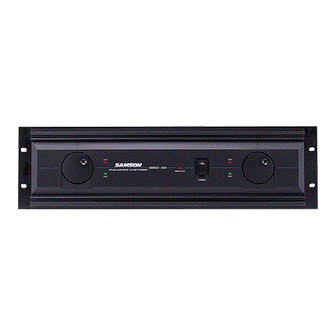
Table of Contents
Advertisement
Advertisement
Table of Contents

Summary of Contents for Samson 170
- Page 1 SERVO 170/260/550 AMPLIFIER OWNERS MANUAL ®...
-
Page 2: Table Of Contents
System Features 4 Guided Tour 5 Servo-550 Front Panel 5 Servo-550 Rear Panel 6 Servo-260 / Servo-170 Front Panel 7 Servo-260 / Servo-170 Rear Panel 8 Setting Up and Using the Servo Amplifier 9 Suggested Applications 10 Appendix A: Compatible Studio Nearfield Monitors 11 Appendix B: Linearity and THD vs. -
Page 3: Introduction
Servo-550, which delivers 275 watts of power per channel (into 4 ohms); the Servo-260, which delivers 130 watts of power per channel (into 4 ohms); and the Servo-170, which delivers 85 watts of power per channel (into 4 ohms). In addition, the Servo-550 provides a mono bridging switch and a binding post (banana jack) output connector. -
Page 4: System Features
• The Servo-550 model delivers 275 watts (into 4 ohms) of power per side. The Servo-260 model delivers 130 watts (into 4 ohms) of power per side. The Servo-170 model delivers 85 watts (into 4 ohms) of power per side. • Optimized for usage in professional and project recording studios as well as live performance, the Servo Amplifier boasts specifications (such as 0.03%... -
Page 5: Guided Tour - Servo-550 Front Panel
Guided Tour - Servo-550 Front Panel CLIP SAMSON STUDIO AMPLIFIER 275 WATT STEREO PROTECTION IDLE 1: Power switch - Use this to power the Servo Amplifier on or off. 2: Channel input controls (left/right) - These 41-position knobs allow you to adjust the input level of the signal arriving at the rear-panel input jacks. -
Page 6: Servo-550 Rear Panel
1/4" TRS (Tip/Ring/Sleeve) jacks, wired as follows: Tip hot, Ring cold, and Sleeve ground. The Servo-550 accepts input levels of any strength but needs at least 0 dBu to achieve maximum power. Guided Tour - Servo-550 Rear Panel SERVO 550 STUDIO AMPLIFIER SAMSON STEREO BRIDGED INPUTS (BALANCED... -
Page 7: Servo-260 / Servo-170 Front Panel
Guided Tour - Servo-260 / Servo-170 Front Panel CLIP SAMSON STUDIO AMPLIFIER 130 WATT STEREO PROTECTION IDLE 1: Power switch - Use this to power the Servo Amplifier on or off. 2: Channel input controls (left/right) - These 41-position knobs allow you to adjust the input level of the signal arriving at the rear-panel input jacks. -
Page 8: Servo-260 / Servo-170 Rear Panel
2: Fuse holder - In the Servo-260, insert a 6 amp, 250 volt fuse here for 115 volt operation, or a 3 amp, 250 volt fuse for 230 volt operation. In the Servo-170, insert a 5 amp, 250 volt fuse here for 115 volt operation, or a 2.5 amp, 250 volt fuse for 230 volt operation. -
Page 9: Setting Up And Using The Servo Amplifier
3. Next, make the signal input connections, using the electronically balanced 1/4" input connectors on the rear panel (or, in the Servo-260 and Servo-170, the unbalanced RCA-type connectors). On the front panel, turn both the left and right Channel input controls fully counterclockwise (to their “ ” setting). -
Page 10: Suggested Applications
Bear in mind that, since the Servo Amplifier is a power amplifier, it requires preamplification of input signal (this is most commonly accomplished by a mixer such as any of the Samson MPL or PL models). -
Page 11: Appendix A: Compatible Nearfield Monitors
Appendix A: Compatible Nearfield Monitors The Samson Servo Amplifier is the perfect system for powering nearfield monitor systems in both professional and project recording studio environments. Although compatible with virtually all nearfield monitors currently on the market, this chart provides a partial listing of some of the more popular models. -
Page 12: Appendix B: Linearity And Thd Vs. Frequency Sweep
AUDIO PRECISION Servo 170 LEVEL(dBr) & THD+N(x) vs FREQ(Hz) 5.0000 4.0000 3.0000 2.0000 1.0000 -1.000 -2.000 -3.000 -4.000 -5.000 Servo-170 Linearity (0 dB Ref) and THD+N vs. frequency sweep (10 Hz - 50 kHz) 1.000 .9000 .8000 .7000 .6000 .5000 .4000 .3000 .2000 .1000 1.000... -
Page 13: Appendix C: Power Output Vs. Thd
AUDIO PRECISION Servo170 THD +N (%) & LEVEL (W) vs FREQ (Hz) 100.00 90.000 80.000 70.000 60.000 50.000 40.000 30.000 20.000 10.000 Servo-170 Power output (-1 dB @ 1 kHz re: 85 W) vs. Total Harmonic Distortion 1.000 .9000 .8000 .7000 .6000 .5000 .4000 .3000 .2000 .1000 1.000... -
Page 14: Appendix D: The Servo Amplifier Protection Circuitry
Appendix D: The Servo Amplifier Protection Circuitry As noted in the “Guided Tour” section of this manual, the Servo Amplifier's front panel Protection light indicates the activity of the relay speaker connection circuitry. When the Protection light is lit, this circuitry is inactive, and all PROTECTION connected speakers are muted (provided with 0 volts DC), thus protecting them and preventing any audible “thump”... -
Page 15: Appendix E: Bridged Mono Mode (Servo-550 Only)
The Servo-550 amplifier provides a rear-panel switch that allows it to be used in a bridged mono mode. When this switch is placed in the “Stereo” (up) position, the Servo-550 functions as a true stereo amplifier, where both of the two independent amplifier channels (left and right) can receive different input signal and produce independent output signal. -
Page 16: Specifications
2. Total Harmonic Distortion (with 30 kHz LPF, 4 ohm) Model 550 @ 275 watts Model 260 @ 130 watts Model 170 @ 85 watts 3. Signal To Noise Ratio (with 80 kHz LPF, all models) Channel R Channel L 4.
















Need help?
Do you have a question about the 170 and is the answer not in the manual?
Questions and answers